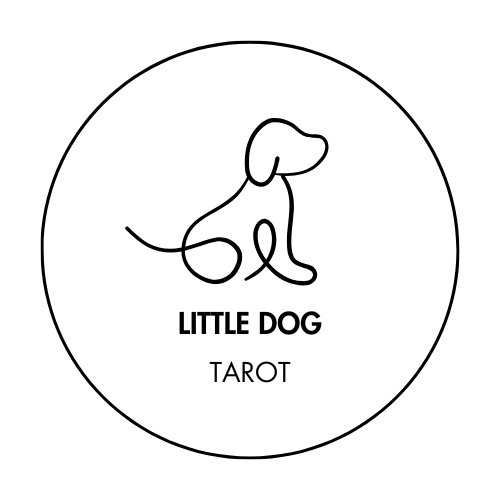
Welcome to Little Dog Tarot!
Tarot for inspiration, reflection, and creativity

About Me
Hi there! I’m Spencer. I’m an author, tarot reader, knitter, dog enthusiast, chronic illness haver, certified queer person, and much, much more. I have a tiny dog named Alfie (Little Dog Tarot’s mascot) and an insatiable curiosity about the ways that storytelling helps us shape our lives. Fiction writing is one outlet for this. Tarot is another.
I believe that tarot can help us make sense of the events in our lives. I think it’s also an incredible tool for approaching the stories we tell others. From following a plot bunny to planning a book, steering a series, or making larger career decisions, tarot can provide inspiration and new ways of looking at old questions. Whatever you’re curious about, tarot has a way of encouraging reflection, discernment, and hope. I would be proud to work with you.
I came up with the name for Little Dog Tarot when looking at The Fool card in my Rider-Waite-Smith deck. I realized suddenly that the little, dancing dog on that card looked remarkably like my little dancing dog (who was not actually dancing, but rather snoozing next to me on the couch at the time). I find animals can be very intuitive, and I love including Alfie in my readings whenever possible. I also think Alfie embodies the optimism, curiosity, and spirit of The Fool. Looking at that card or at him never fails to make me smile.
What to Expect in a Reading
- I currently do four types of readings:
- 1 card – $15
- 3 cards – $30
- 6 cards – $50
- 10 cards – $90
- My rates are based on how long it takes me to conduct the reading. It’s not just a matter of adding more cards. Each new card allows for new relationships and connections to be drawn among the other cards. I want to give you as thorough and helpful a reading as I can.
- Currently, I’m doing asynchronous readings only. That means I’ll send you detailed pictures of your cards and a written explanation and interpretation. I’m not doing video readings at this time, but am planning on offering them in the future (just gotta figure the tech out).
- You can pick the deck I use to read for you from the options pictured below. You can also tell me if you want Alfie to pick one of the cards in your reading. I’ll ask you to tell me the question you want the reading to focus on, and you can choose from a few different spreads.
Types of Questions to Ask
- Tarot can handle all sorts of questions. If you’re thinking about a creative project, it can do anything from providing a first glimmer of inspiration to helping map out a plot or even a series. If you’re thinking about your life, it can do so much more than just predictions. It can also delve into the past, explore possible options, look at might-have-beens, and examine any area of your present life.
- There’s a kind of sweet-spot for how specific you want your questions to be. “Tell me my future,” is a little too broad. “Tell me the exact date I will get married,” is a little too specific. “What does my love life look like for the rest of this year?” is perfect.
- I think tarot works best when the question is focused on you, the querent (question asker), rather than a third party. Rather than asking, “What the hell is wrong with my roommate?” it works better to ask, “What can I do to improve [X issue] with my roommate?”
- I will keep your personal info and question confidential, even if your hypothetical roommate in the above scenario also books a reading with me. The only time I will share information you tell me in a reading is if I believe you are in clear and immediate danger of harming yourself or someone else.
- I take a common sense approach to this. I’m not going to report you to anyone because you tell me you’re depressed. I will, however, report you to the police if you tell me a specific plan for killing your neighbor. (Please don’t do that—either killing your neighbor or telling me about it. There are better options.)
How to Book a Reading
- Shoot me an email at spencer [at] spencerspears dot com, or send me a Facebook message. I’ll let you know my schedule and we can set up a timeline that makes sense. I read tarot in addition to writing, so I can’t always do a reading immediately, but I can usually do it within a few days of your request.
- You can pick the deck you want me to use, and also let me know if you want Alfie to pick one of your cards. You’ll tell me your question, and you can pick from a few different spreads.
- All payments will be made via PayPal, in advance of the reading.
FAQs
- So is tarot really magic, or what?
My honest answer is that I don’t know, and I’m not sure the question matters that much. Is there a supernatural force (God, Spirit, the Universe, etc.) sending out messages through the cards? Or are the cards just tools for deeper self-knowledge and inspiration? Does the answer actually change the way we live our lives? - How should I use tarot?
Tarot can be used for prediction. It can also be used for introspection, for exploring hypotheticals, for examining the past, for creating stories, and for just about any who, what, where, when, why, or how question you can come up with. Maybe there is a prime mover behind the scenes. Maybe there’s not. In any case, we should never make huge decisions just because tarot “said so.” We should also use reason, past experience, logic, emotion, counsel from trusted advisors, and our own discernment processes. Tarot is just one tool in our tool belts. - What is your personal belief system?
My own personal beliefs are of the agnostic variety. I’m not quite what you would call a believer, but I’m not ruling anything out. I find philosophy and theology to be fascinating subjects, and I think tarot can be compatible with just about any belief system, as long as the querent (the question-asker) feels okay about it. - Why do you mention you’re a queer person? Why is that relevant?
As a queer person, I find some traditional ways of reading tarot cards to be frustrating. Tarot has been used for divination for centuries, and our social norms have changed a lot in that time. There can be misogynist, homophobic, and anti-trans messages in tarot (among many other -ists and -isms), and if you always read the cards in the “traditional” way, you can end up passing on some of those messages, consciously or unconsciously. But tradition, like language, changes over time. New norms overtake old ones. Nothing is static.
When I read tarot, I try to reverse those harmful messages whenever I can. I don’t think court cards are particularly gendered, no matter the pictures on their faces. I don’t think The Lovers always implies a heterosexual match. I don’t think Cups and Pentacles always represent feminine energy and Swords and Wands represent the masculine. I’d be hard pressed to define feminine or masculine energy anyway—is there a way to do it that isn’t bioessentialist or just repeating existing norms? When I read, I am always striving to meet people where they’re at, and build a reading that makes sense for them. - Why do you mention having chronic illness?
I also find some traditional ways of reading tarot to be frustrating as a person with a chronic illness. Many common descriptions of tarot cards presuppose the querent (question-asker) lives independently, has a full-time job or school schedule, and is able-bodied. People with disabilities, chronic pain, and chronic illness (visible or invisible) know that this isn’t always the case.
Our western culture values the individual over the community, hustle culture over rest, and monetary gain and productivity over sustainability and connection. But if you have a chronic condition, you learn that you have to value things that our dominant culture dismisses, because the dominant culture has no room for those who can’t “measure up” to its endless individualist, scarcity-minded grindset.
When I read tarot, I do it from my perspective as someone with a chronic illness. I look for ways to create meaning in our lives no matter what those lives look like. As some very wise people have said, we’re all just temporarily-abled, and it’s important to find joy in that which lasts beyond the time limit of our “usefulness” to productivity culture.
Decks that Can Be Used in Your Reading
(I update this whenever I get a new deck that I like. I am an inveterate deck collector.)

The Rider-Waite-Smith deck is the classic tarot deck. Originally published by William Rider in the early 20th century, the deck was illustrated by Pamela Colman Smith and based on the writing of A. E. Waite. Whether you like or dislike the deck’s bright, primary colors and old-fashioned illustrations, it’s one you’ll recognize. Most other tarot decks, whether they hew close to this original or turn away from it, are in conversation with it in some way. Many traditional card interpretations reference the art in this deck. If you’re not sure which deck to use, this is a solid choice.
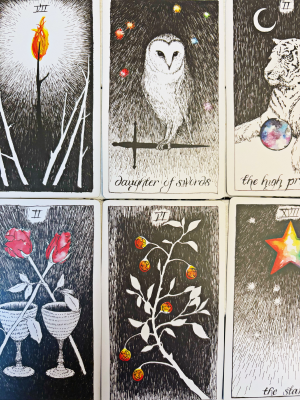
The Wild Unknown Tarot deck by Kim Krans was developed in 2012. I love the way this deck references nature. Most of the cards are have predominantly black and white drawings with pops of color. This was the very first tarot deck I ever bought (I do not subscribe to the idea that decks should only be given as gifts), and I will always have a soft spot for it.
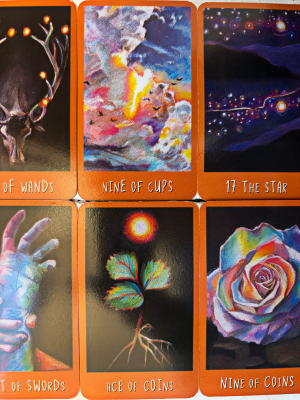
The Raven’s Prophecy Tarot by Maggie Stiefvater was developed in 2015. Stiefvater is a writer, and I adore using this book when I have questions pertaining to my creative work. The imagery on this deck is some of my favorite, and multiple cards in this deck have tattooed themselves on my brain.
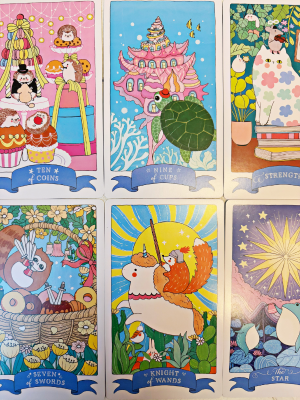
The Kawaii Tarot deck by Lulu Mayo was developed in 2022. It’s super cute, and I love the lighthearted touch it brings to tarot. Sometimes we get caught up in life’s dark places, and our thinking gets mired in the depths. I like to use this deck when I need to be reminded that fun and joy still exist in the world.
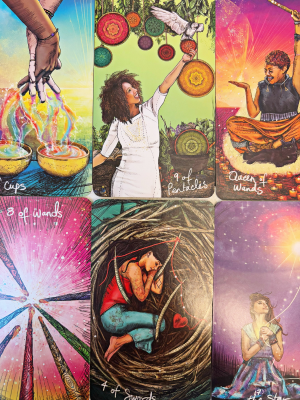
The Light Seer’s Tarot by Chris-Anne was developed in 2019. I love the use of color in this deck, it’s so vibrant. I personally find this deck very helpful when dealing with bigger, more serious questions, but I think it can be just as useful for every day situations. This deck, as they say, sparks joy.
